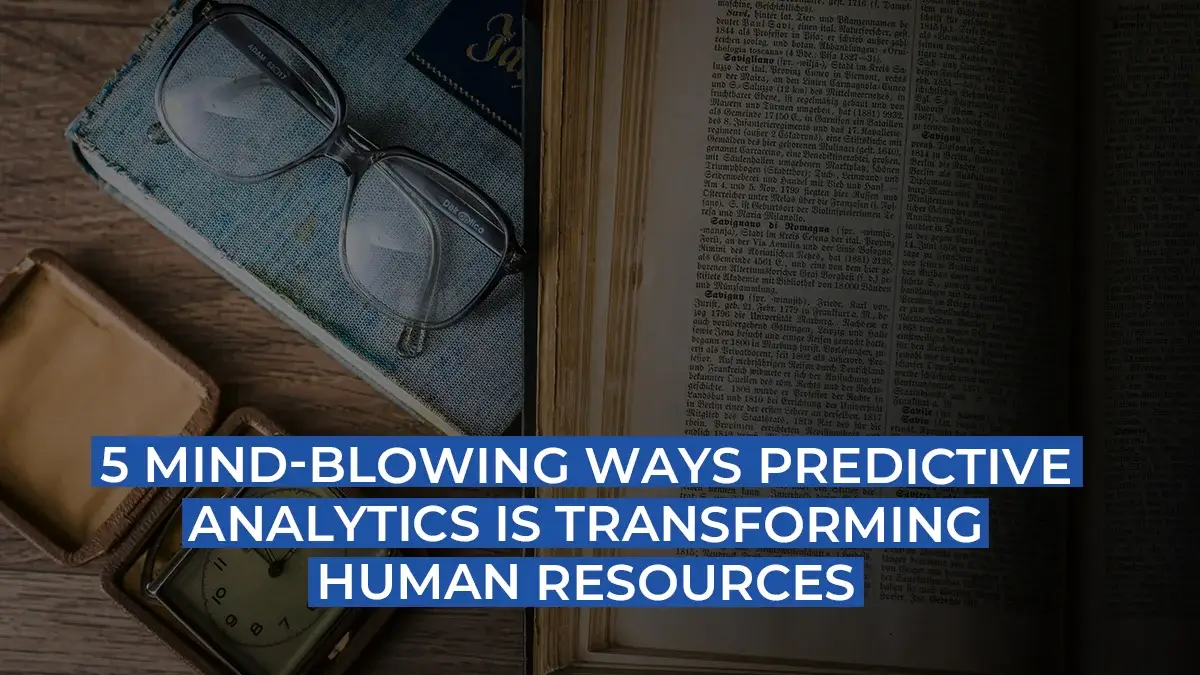5 Mind-blowing ways predictive analytics is transforming human resources

Here's What We've Covered!
Under the large umbrella of business analytics, predictive analytics is transforming the way businesses experience growth and decision making. And it is only expanding with time. In fact, in 2023, the global predictive analytics market was valued at $10.2 billion, and is estimated to reach $63.3 billion by 2032. And at its current rate, the field is only expected to flourish in the coming years.
A good part of this estimation of upward growth is credited to the wide range of applications predictive analytics has. It has been adopted across many different industries, their sectors, and sub-sectors, including finance, healthcare, marketing, manufacturing, retail, and human resources. The use of predictive analytics in human resources is rapidly increasing, with a variety of applications that make the industry function more smoothly and efficiently.
Also Read- What Is Predictive Analytics? Usage, Algorithms & How To Learn
Applications of Predictive Analytics in Human Resources
Predictive analytics empowers HR departments to move beyond traditional methods by leveraging the modern, data-driven insights. By making more informed decisions, they can optimise their operations and perform with a strategic, efficient approach. The HR department has many different functions and operations which can benefit from the implementation of predictive analytics. Here’s a detailed breakdown of the key areas in human resources where predictive analytics is making a difference:
1. Talent Acquisition and Retention
Predictive analytics is useful in sourcing candidates and screening through their applications more efficiently. With the help of predictive modelling, candidate success is determined based on factors like education, skills, experience, and personality traits. AI-powered tools are also used to automate resume screening by identifying potential candidates across platforms and prioritising candidates based on their predicted fit.
Example: Based on a candidate’s past performance in similar roles, skills, cultural fit as assessed with personality tests or interviews, a model can predict which candidates are most likely to succeed in the current role.
Google’s Predictive Hiring
One of the leading tech firms globally, Google has adopted high-end predictive analytics methodologies to enhance their HR-related functions like recruitment. From 15-25 rounds of interviews which occupied 125 full-time recruiters to hire 1000 people was transformed with less than five rounds of interview. With the help of predictive analytics, the median time per candidate was reduced from 180 days to 47 days. Predictive analytics has helped save a lot of time and energy on the recruiter as well as the candidate’s ends, making the process a lot more efficient.
2. Employee Engagement
By analysing metrics like work-life balance, communication, and recognition with employee engagement surveys, HR professionals identify areas of improvement for the employees. It also helps in identifying what factors can impact employee engagement, for the HR department to consider and improve upon, like leadership, team work, etc.
Example: Predictive analytics can be used to identify employees at high risk of burnout by analysing factors like work hours, engagement score, and overtime, and interventions can be implemented to make flexible arrangements for the employees and improve their well-being.
LinkedIn’s Predictive Employee Engagement
LinkedIn leverages data analytics to understand employee engagement and identify and predict any potential issues before they become critical. LinkedIn analytics also enables businesses to track employee engagement and the impact the posts have, which can help measure the employee advocacy of the team.
3. Employee Performance Management
Predictive analytics significantly enhances employee performance and engagement by providing insights into factors that influence employee satisfaction, productivity, and motivation. By building predictive models to identify employees at high-risk of leaving, proactive interventions can be taken to implement targeted retention strategies and predict employee churn. With the help of performance data, skill assessments and other factors, high-potential employees are identified to prepare them for future leadership roles.
Example: By analysing employee engagement, work communication, and other factors, companies can identify employees at high risk of burnout, and take proactive measures to retain the employees.
Fortune 500’s Performance Management
Fortune 500 implemented predictive analytics tools to analyse employee satisfaction and performance rates. In just about a year, potential resignations were predicted with 95% accuracy, and the proactive address of issues led to a 15% decrease in attrition. The practice of predictive analytics alone has helped improve employee performance and engagement rate to a great extent.
4. Workforce Planning
Yet another area where predictive analytics play a crucial role is workforce planning. By analysing market trends, historical data, and internal factors, HR professionals can anticipate future workforce needs and take measures to address any potential challenges that might come in the way. Industry trends, technological advancements, and business objectives can help predict future skill requirements and anticipate hiring trends accordingly.
Example: In IT, predictive analytics can be used to anticipate the future demand for specific skills and adjust company’s recruitment and training programs accordingly.
Amazon’s Workforce Planning
Amidst its rapid growth and global operations, Amazon constantly faces the challenge of having the right workforce at the right time. With the help of demand forecasting and skill gap analysis, Amazon predicts future labour needs across various roles in different regions. It considers factors like business expansion plans, peak periods, and seasonal demand fluctuations, which has helped optimise staffing levels and improve workforce planning.
5. Learning and Development
Training and development programs within HR significantly impact the employee’s learning experiences. By analysing employee data, organisations identify training needs, predict future skill gaps, and personalise the learning and training experience for the employees. These programs are curated by catering to individual needs, skills, and career goals, and measured for their effectiveness to understand their impact.
Example: Based on their current skills, performance, and career goals, predictive analytics can help identify employees in a tech company which would most benefit from advanced data science training and can facilitate training courses for them.
Amazon’s Predictive Learning and Development Programs
Amazon faced the challenge of ensuring its employees have the knowledge and skills to adapt to fluctuating market trends, demands, and business needs. Since providing effective and relevant training can be complex and costly, it required a more cost-effective approach. With the help of predictive analytics, Amazon analysed employee skills, performance data, and business requirements to identify critical skill gaps and initiate learning and training programs to close such gaps.
Also Read- Top 5 Predictive Analytics Tools for Smarter Business Decisions in 2025
Tools Used in Predictive Analytics in Human Resources
There are many predictive analytics tools utilised by human resources. Some tools can be quite general, like Excel, or common business analytics tools like Tableau, Python, etc., which focus on data visualisation, data exploration, and simple analyses. Beyond these popular tools, there are some HR-specific tools available which solely focus on HR analytics and are designed to enhance HR processes largely. Following are key HR-specific predictive analytics tools and their unique features that have proven to be very effective for the HR department:
1. Oracle HCM Cloud
- Strong analytical capabilities
- Optimal for predictive modelling for workforce planning and talent acquisition
2. Workday
- Built-in analytical capabilities
- Best for workforce planning
- Suitable for talent acquisition analytics and performance analysis
3. Visier
- Cloud-based HR analytics planning platform
- Offers advanced features like workforce planning and compensation analysis
4. Cornerstone OnDemand
- Learning and development platform
- Effectively tracks training
- Identifies skill gaps and helps personalise learning paths
5. Machine Learning Platforms
- Amazon SageMaker, Google Cloud AI Platform, Microsoft Azure Machine Learning
- All these cloud-based platforms include model training, deployment, as well as monitoring.
Also Read- 5 Ways How Business Analytics is Revolutionizing Finance In 2025
Traditional Human Resources vs Predictive Analytics in HR
| Feature | Traditional Human Resources Practices | Predictive Analytics in Human Resources |
| Approach | Decisions are based on gut feelings, anecdotal evidence, and past experiences. | Historical data is optimised to make decisions that are informed with data and advanced analytics. |
| Data usage | The primary approach is to collect and analyse basic HR metrics, limiting the scope of data usage. | There is major reliance on data, which drives and determines the many decisions businesses can make. |
| Focus | It majorly focuses on administrative tasks like benefits administration and payroll processing. | The focus is shifted from administrative tasks to strategic initiatives like talent acquisition, workforce planning, etc. |
| Technology | The approach is to consider manual processes like spreadsheets for data management and analysis. | It employs artificial intelligence, machine learning, and other technologies to analyse data and gain insights. |
| Decision making | Traditional human resources practices have been more reactive, leading to decisions based on experience and intuition. | Predictive analytics in human resources has made it more proactive, leading to decisions based on evidence and data. |
Benefits of Predictive HR Analytics
Predictive analytics is widely used in HR for the many benefits it reaps. It offers a wealth of benefits for organisations, which not only prepare them for the future, but also make a huge difference in the long-term functionalities of the department. By starting early and efficiently, organisations can solve the root problems and make their operations advanced and more fruitful in the long run. Here are some benefits of predictive HR analytics:
1. Improved Talent Acquisition
With the help of predictive analytics and candidate screening, it becomes easier to identify the best-fit candidates, leading to increased employee performance and reduced turnover. The recruitment process is also a lot more streamlined with automated tasks, which not only makes the time-to-hire a little faster but also reduces the cost-per-hire.
2. Enhanced Employee Retention
Through many different employee metrics like engagement surveys, performance metrics, etc., HR professionals can identify employees at high-risk of leaving and implement proactive retention strategies. The data can be further used to improve employee engagement by identifying factors that drive engagement and address any potential issues right away.
3. Reduced Costs
The recruitment costs are highly reduced since advertising, agency fees, time-to-hire, all these costs are optimised. The costs associated with employee turnover, like recruitment, training, and lost productivity can also be minimised with predictive analytics. With better retention strategies, employee turnover can be improved, which will reduce its financial impact as well.
4. Increased Productivity and Performance
By leveraging predictive analytics, HR professionals can identify high-potential employees and develop their skills for future leadership roles and success. They can also identify the skill gaps or employee demands by curating tailor-made training programs catering to their individual needs and measure their impact on performance. With the help of optimised workforce planning, organisations can predict future workforce needs and plan accordingly.
5. Data-driven Decision Making
Moving from traditional HR practices to the modern use of predictive analytics in human resources, the decision making process is also improved to a great extent. The traditional approach led to experience and intuition-driven decision making, however, with predictive analytics, decisions can now be data-driven and more informed. It provides valuable insights and a solid ground for HR professionals to base their decisions on, and improve all HR functions.
Also Read- Top 5 Predictive Analytics Tools for Smarter Business Decisions in 2025
Emerging Trends in Human Resource Analytics
As the field continues to evolve, there are many new trends and advancements emerging in the future world of predictive analytics. Such technological evolvements will not enhance HR functions, and make them more efficient in terms of time, effort and energy. There is a lot of data generated on a daily basis, and newly introduced technology will only open doors of opportunities for the HR field to explore. Following are the emerging trends in human resource analytics:
1. People Analytics
An exciting introduction to predictive analytics, people analytics will focus more on employees. It will go beyond regular HR functions by using data to understand and optimise the entire workforce on many different fronts. The focus of people analytics will be to analyse employee behaviour, attitudes, and performance, to drive business outcomes which are more efficient. For example, by analysing employee sentiment, HR professionals will be able to identify high-performing teams, and gauge the impact of employee well-being on productivity.
2. AI and ML
While artificial intelligence (AI) and machine learning (ML) are already in use in predictive analytics, they will only become better in the coming years. Both AI and ML will be crucial in automating tasks like resume screening, scheduling interviews, and forecasting future workforce needs. With predictive modelling and machine learning algorithms, it will become easier to identify patterns and make more accurate decisions. Employee questions can be answered with well-trained AI chatbots to provide support and assist with administrative tasks.
3. Remote Work Analytics
It becomes a challenge to measure employee performance when the employees are working remotely. By monitoring employee productivity, HR professionals can measure employee engagement and productivity even in remote work environments. It will also help in identifying potential issues such as lack of collaboration, work-life balance, isolation, etc. With the help of data, remote work policies can be made more flexible and supportive, to optimise remote work productivity and engagement of the employees.
4. Real-time Analytics
The continuous monitoring of employee data like performance data and engagement surveys, HR professionals can identify any emerging trends and issues in real-time. It will enable them to address these issues proactively and take corrective measures based on data-driven insights. Such real-time data allows them to make more informed decisions based on real-time data, which leads to addressing employee issues more quickly and efficiently.
5. Ethical AI and Data Privacy
Among all the other trends and advancements, one major point of concern remains ethical considerations. Employee data should ensure compliance with data privacy regulations, and employee data should be protected. The AI-powered HR systems should be identified and mitigated for fair and equitable outcomes for all employees. The entire process should be transparent and explainable, leaving no part uncertain or difficult to understand.
Also Read- 5 Key Applications of Business Analytics in Supply Chain Success
Learn Business Analytics with IMS Proschool
The field of business analytics is constantly growing, and so are the industry demands for business analysts. Analytical and problem-solving skills are best leveraged by business analysts, which can help businesses make more strategic and data-driven decisions. And what better than IMS Proschool to learn business analytics with? The Business Analytics Program by IMS Proschool is one of the most comprehensive courses out there. Here are some highlights of the course:
- IMS Proschool is ranked among India’s top 10 analytics institutes. Talk about credibility!
- The course is quite holistic, where you can learn from theoretical knowledge and by solving 15+ case studies and projects.
- Business analytics requires a good understanding of programming languages, but this course is open to coders and non-coders both!
- Learn the business analytics tools high in demand, like Excel, SQL, Power BI, Python, and Tableau.
- There are placements across 30+ companies with 800+ roles for you to find your best fit! Join the course right away!
Conclusion
By leveraging predictive analytics, HR departments can witness a complete transformation and enhance their functions. It will empower them to shift their focus from administrative tasks and move on to more strategic planning and thinking, develop plans and initiatives based on data-driven insights, and drive success through a data-driven approach. Not only does predictive analytics make functions more smooth and quick, but also quite efficient in the long run!
Frequently Asked Questions
1. What are predictive analytics in human resources?
Predictive analytics in human resources use data and statistical modelling/machine learning algorithms to forecast future HR-related outcomes. It works beyond simply analysing past data, it also aims to anticipate future trends and events related to workforce planning and enhancement.
2. How is predictive analytics used in human resources?
Predictive analytics is used in human resources to improve talent acquisition, employee retention, enhance performance management, and better workforce planning. It focuses on all HR-related tasks, and makes the decision-making process more data-driven and future-proof.
3. What is the future of human resource analytics?
The future of human resource analytics will have an increase in the use of AI and ML algorithms which will be more sophisticated and advanced. The integration of predictive analytics with other HR systems like learning management systems, performance management systems, etc., will create a more holistic view of the workforce and efficient task allocation.
4. What are the benefits of human resource analytics?
The benefits of implementing human resource analytics include improved decision making, increased efficiency and productivity, reduced, costs, enhanced employee engagement and performance, and a competitive advantage with future-proof strategies in place.
Resent Post
>
How to Find ACCA Jobs Online After Qualifying: Real Portals, Tips & Career Guidance
>
Financial Modelling Classes in Hyderabad: Your Guide to the Best Institutes
>
Still Paying CFA Enrollment Fees? Here’s the Big 2026 Update!
>
How to Use myACCA Like a Pro: Dashboard, Exams, Deadlines & More!
>
Difference Between Financial Accounting and Management Accounting: A Complete Guide



